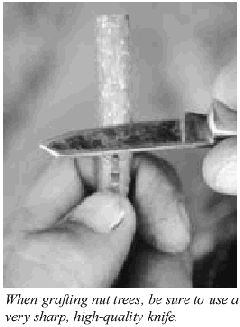Despite the cold winter weather, spring will soon be upon us. Those interested in establishing nut tree plantations this year should begin now to develop a plan of action — including securing all necessary supplies and materials that will be needed in a few months.
 A few tools are required to begin
your nut tree planting. Perhaps the
most important tool is simply information.
For example, grafted black
walnut trees will usually bear nuts
five to eight years after grafting.
For pecans, this timeline is a bit
longer — usually seven to 10 years,
depending on the cultivar. Choosing
the right cultivar to buy or to graft is
very important. Two key information
sources to consult are members
of the Missouri Nut Growers Association
(MoNGA) and the staff of
the University of Missouri Center
for Agroforestry (UMCA).
I recommend attending the upcoming
meeting of the MoNGA in
Nevada, Mo., on Saturday, Feb. 7th.
This meeting offers the annual “Nut
Show,” where growers from across
the state bring nut samples for evaluation.
Meeting attendees will also
provide an opportunity to locate
sources for the “scion” sticks needed
to graft desired cultivars and a
date for a spring “Grafting Day”
will be set.
A few tools are required to begin
your nut tree planting. Perhaps the
most important tool is simply information.
For example, grafted black
walnut trees will usually bear nuts
five to eight years after grafting.
For pecans, this timeline is a bit
longer — usually seven to 10 years,
depending on the cultivar. Choosing
the right cultivar to buy or to graft is
very important. Two key information
sources to consult are members
of the Missouri Nut Growers Association
(MoNGA) and the staff of
the University of Missouri Center
for Agroforestry (UMCA).
I recommend attending the upcoming
meeting of the MoNGA in
Nevada, Mo., on Saturday, Feb. 7th.
This meeting offers the annual “Nut
Show,” where growers from across
the state bring nut samples for evaluation.
Meeting attendees will also
provide an opportunity to locate
sources for the “scion” sticks needed
to graft desired cultivars and a
date for a spring “Grafting Day”
will be set.
Another excellent source of information on grafting techniques for nut trees is a publication entitled, “Propagating Pecan and Black Walnut” by Dr. William Reid. This publication is available from UMCA online or by mail with the information listed below. Excellent guides for pecan and chestnut are also available, and a black walnut growers’ guide will be available soon.
What else do you need besides information? A good, sharp knife is an obvious starting point. You will also need a pair of pruning shears — again, good and sharp. The grafting technique(s) you select should depend on the diameter of the trees you will be working on, and the cut surfaces of the scion and rootstocks will need to be strongly bound together to facilitate the healing process. Some propagators prefer to use grafting tape, while others use grafting bands, which are similar to elastic bands.
You may choose to locate suppliers of grafting tools and equipment online by typing “grafting supplies” into your favorite search engine.
Grafting Knife Suppliers:
A.M. Leonard Inc.
P.O. Box 816
Piqua, Ohio 45356
Gempler’s
P.O. Box 44993
Madison, Wis., 53744
(800) 382-6744
www.gemplers.com
For UMCA guides and information:
visit www.centerforagroforestry.org;
call (573) 882-9866; or write
UMCA
Information Specialist
203 ABNR
Columbia, Mo. 65211